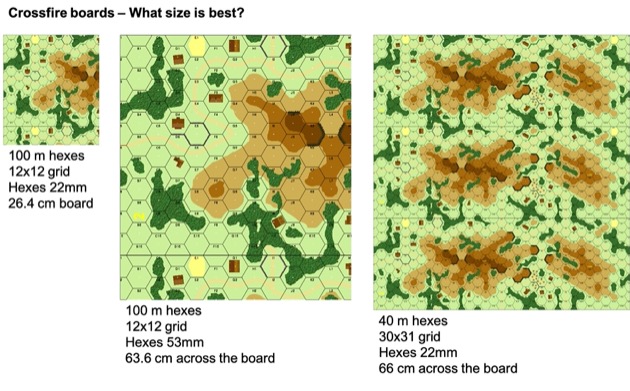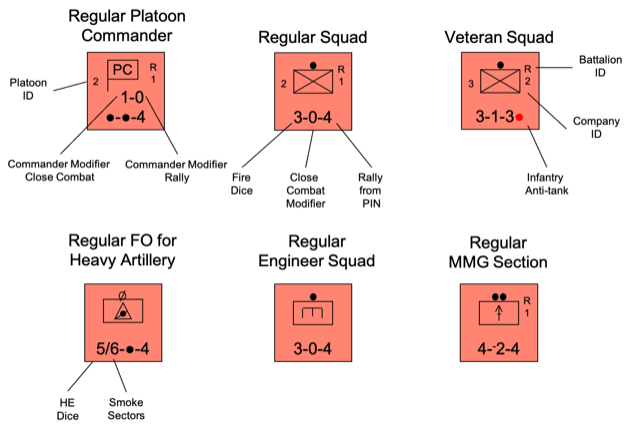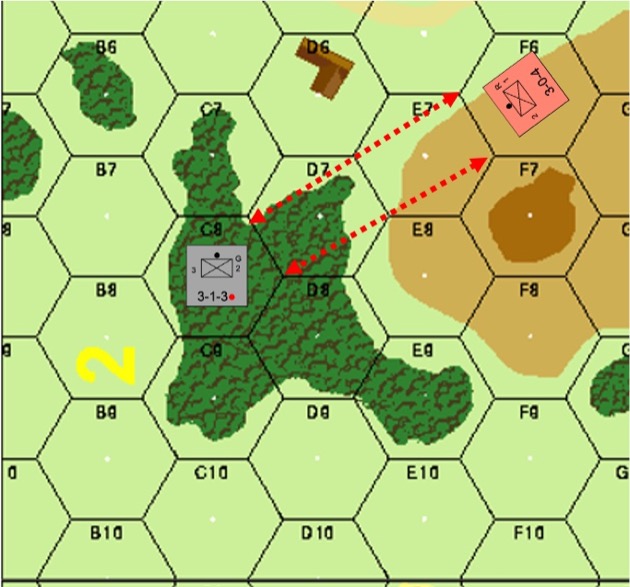Crossfire is not a board game. But it could be. This is a bit of a thought experiment on what Crossfire might look like as a board game. It all came about one Saturday morning when I was having a WhatsApp conversation with my wargaming crew on “Crossfire as a board game”. I got all keen and made some counters. So here is how I see it …
Board
There would be a board, of course. It is Crossfire so there will be lots of terrain. And there would be hexes. The number of hexes on a particular board depends on how big a piece of land each hex is meant to represent.
Rather than draw my own maps I thought I’d steal from Advanced Squad Leader (ASL) and see what that offers. I have used ASL Official Board 2, which is described as “Hills; two level three hills, light woods”.
40 metre hexes
ASL has boards with 10 x 31 hexes, each 22 mm from edge to edge. Each hex in ASL is approximately 40 metre across. For bigger games you put two or more of these boards together.
That works for Crossfire too. I assume 1:1,000 scale as the Crossfire Ground Scale. So a 3cm wide base corresponds to about 30 metres in reality. 40 metre, the size of a hex, is about the right space for a stand in the table-top game (30 metres), with a bit of space around it.
That suggests one counter per hex, and a stacking limit of one counter per hex. There would be the usual Crossfire exceptions of FOs and commanders.
A small 1.2m x 1.2m (4’x4′) table would need 30 hexes by 30 hexes. This assume 40m per hex and, at 1:1,000 scale, the table represents an area 1.2km x 1.2km. 30 hexes x 30 hexes is just about three ASL boards size by side (each is 31 hexes by 10 hexes so you get 31 hexes by 30 hexes).

That is a lot of hexes. It looks alright but it doesn’t look like my Crossfire tables.
100 metre hexes
Another way to go is to make each hex the space required for a small on-table area terrain feature. My smallest area terrain features are 10cm (4″) across and contain up to four squads. At 1:1,000 ground scale that is roughly 100 metres of real estate.
The bigger ground scale suggests a stacking limit of four counters. Remember Crossfire’s guideline that a small feature should be able to contain 4-6 squads. That seems alright to me given Infantry unit frontages during WW2. Platoons of most nations attacked on a 100m frontage, so in the board game would be stacked in one hex. Platoons defended 200-300m, sometimes wider. This would be with the squad counters of the platoon being more spread out.
A small 4’x4′ table would need 12 hexes by 12 hexes. To get an idea what that would look like I hacked together one from the same ASL board I used above. Given an ASL board is 10 x 31 hexes, I had to cut down the length (from 31 to 12 hexes) and then widen it (from 10 to 12 hexes).

I like this. Looks like a Crossfire table. It could do with more terrain, but this board is “light woods”.
A 12 x 12 hex board would be 26.4 cm across. That is quite small. Perfect as a pocket game, but multiple units in one hex would be fiddly.
I’d be tempted to go for bigger hexes on the board. Deluxe Advanced Squad Leader has 53 mm hexes rather than the normal 22 mm. That size would make managing multiple units in the same hex much easier. This bigger board, even with only 12 hexes on it, would be 63.6 cm across. A couple of feet. Seems about right. But then that is now competing with the board for the 40 metre hexes. Hmmm.

Maybe the 40 metre hexes is better after all.
Counters for units
In ASL, there are 1/2″ and 5/8″ counters (for Guns and Vehicles and Fortifications) and that difference is important in the rules. So I guess our Crossfire board game would be similar. 1/2″ (12mm) counters for squads and MG sections. The bigger 5/8″ counters for tanks, AFVS and guns.

Most counters are squads. There are some teams (FOs) and some sections (machine guns). Actually I don’t know whether the MMG unit should be a section or platoon. But hey.
For a squad, the first number is the dice rolled for shooting. The second is the close combat modifier (often zero). The third is the morale check for a rally from PIN.
Commanders have those basic attributes, but often they are dot, i.e. have no value. But they do have their commander modifiers, which I put in as a top line. These are for when they support their subordinate squads. Close combat and rally e.g. PC(+1) or PC(+1/0)
The forward observer (FO) is a bit different. The “fire” number turns into two numbers. The first of these is the barrage dice and the second number is smoke sectors. The number of sectors should be the number of hexes. The example is 6 sectors (for heavy artillery) and that would work for the 40 metre hexes. For the 100 metre hexes the smoke would be smaller e.g. 3 for heavy artillery.
Markers for unit status
Crossfire has PIN, SUPPRESS, GROUND HUG, and NO FIRE statuses. Everybody finds their own way of marking stands with this statuses. The board game needs a mechanism too.
The simplest is to have additional counters for these. Put a PIN counter about a unit counter to show it is PINNED. Ditto for SUPPRESSED etc. This would probably work with 40 metre hexes. 100 metre hexes probably get a bit messy, with multiple units in a hex each with different statuses.
Making the unit counters two sided reduces this clutter. Probably with SUPPRESSED on the back because it can’t shoot and its rally score is worse (higher)

Line of Sight
Crossfire is heavily reliant on line of sight (LOS), so the board game would need a clear definition of what line of sight means. Something like, LOS can enter blocking terrain, and pass through any contiguous hexes of the same blocking terrain, but cannot leave that blocking terrain.
Centre to Centre LOS
Crossfire uses the line from centre of one stand to the centre of the other to determine LOS. We could do that in the board game.

The example has a Russian Rifle Squad and three German stands (MMG, Rifle Squad, Engineer). The two rifle squads can see each other. There are multiple hexes of woods in between, but these are contiguous with the wood hex the German is in, so do not block line of sight.
The Russian and the German machine gun cannot see each other. A contour line is in between.
The Russian and the German engineer also cannot see each other. Line of sight is blocked by the woods feature. It might also be blocked by the house, but I gave it the benefit of the doubt. Probably, as a board game, we should have clearer rules so avoid the need for a judgement call.
Nearest Hex Point
I think a tighter rule is to draw a line from the two nearest hex points.

The rifles squads still see each other, as above. And the Russian and German machine gun cannot see each other.
But the ambiguity on the Russian and the engineer is removed. The line of sight from nearest hex point to nearest hex point crosses both the blocking wood (as above) but also clearly crosses the building. So LOS is blocked for two reasons.
What about when there is a straight line of hexes between the units. In this case there are two sets of “nearest hex points” but both of them show give the same result in terms of line of sight. In the following example the two rifle squads can see each other.

But what about if the two nearest hex points are at each end of a hex side, and one adjacent hex blocks and the other doesn’t? I think, in this case, LOS is blocked.

I’m sure i could go on. Oh, my god, it is a minefield.
Within a stand width
A stand width is the only measurement in Crossfire. With 40 metre hexes this would be “in same or adjacent hex”. With 100 metre hexes this would be “in same hex or trying to close assault this hex”.
Close assault
With 40 metre hexes move adjacent and then close assault. Winner moves into the target hex.
With 100 metre hexes might go further and move into the target hex. Winner stays in the target hex; loser eliminated.
Conclusion
So is it possible to convert Crossfire to a board game? Sure it is.
Would this get more people involved in Crossfire? It might do. Although it would probably be a mostly separate group from those who play the table top version.
Will I make a Crossfire board game? Not any time soon. Perhaps if I go on a camping trip with my wargaming buddies and want to take along a game to play.
Was this a fun exercise? Absolutely.


A fantastic idea – I had been toying with the idea of using hexes with miniatures for CF, with a view to delineating terrain by area. There is a lot of food for thought in this post.
Fantastic post! I play Crossfire with wooden blocks and printed maps (either period maps or google earth screen captures printed in sepia or BW) and it works perfectly ‘as is’, with no rule modification whatsoever. I use 10mm cubes for sections, with simple color-coded labels showing their state on different faces. I can fit Dick Bryant’s 2’x2′ maps on a 20×20 cm map in this way, and a 60×40 cm map easily accomodates 2-3 companies per side.
However, I’ve never used hexes! I think hexes are fantastic for handling ranges and ZOCs, but I’m not sure they actually make your life easier in Crossfire… possibly the opposite. Admittedly, they would make remote play much easier.
Blocks. Wow, super cool idea. I’ve now followed your blog.
And then I spent the entire afternoon exploring Block Games.
10mm is quite small from what I can gather. Columbia do 20mm or 24mm blocks. Do you find the 10mm cubes fiddly?
Well, larger blocks give a better tactile experience for sure, but my goal is to trim miniature wargames’ footprints as much as possible to make them fit my (very) limited available space…
Are 10mm cubes fiddlier than Columbia’s blocks? Sure. Are they as fiddly as cardboard counters? Not at all. I’d say they’re in fact less fiddly than even the larger, 1-inch ‘deluxe’ counters found in some games. It’s their 3D-ness that makes them easier to move around- anything at least 10mm thick is much easier to pick up than flat counters. You can “try your hand at it” with 10mm dice if you have some around!
How’s about 16mm cubes , for use on Deluxe ASL boards ?
https://www.spielematerial.de/en/game-components/game-pieces/wooden-cubes-and-octogons/cube-16-mm.html
“I got all keen and made some counters.” Of course you did. Otherwise this wouldn’t be Steven’s Balagan. 🙂
Quips aside, I agree with the Duc, this is an interesting idea.
I’m puzzled though by your preoccupation with gridding the board. As you have often written, Crossfire is impressive particularly because it mostly does away with measurements. So whether you create this as a virtual system* or a physical one, surely all you need is a straight edge of an appropriate length and a base with template? Am I missing something? I may well be as I’m nothing like so clued up about Crossfire as you.
*I’m already wondering whether to try knocking up a Vassal or Zun Tzu module.
Regards, Chris
IanH makes the point about ease of play remotely. But that wasn’t why I did a hex grid. The hex grid was because that was the challenge. A Crossfire as hex and counter board game.
Crossfire would work, without changes, with blocks (nods to MarkusB) or just units on a table/map that is smaller than normal. 40% of the table size if using 12mm counters, so a 4’x4′ (120cm x 120cm) table would be only 19″ x 19″ (48cm x 48cm).
So I check the text twice for errors and still I only spot the mistake straight after posting it. “base with template”? Nope, “base width template”. Gnash, grind.
One advantage of having the grid is that it makes it easy to play the game remotely with someone else. Either by email (“squad moves from B8 to B6”) or by using an online system like Vassal.
Been thinking about this for years. Take your existing Balagan hex maps (did anyone notice your woods terrain pieces etc are amalgamated hexes?) and tile them with smaller hexes (I have some approaches of hexes within hexes you could try). 6 mm figures, 1 cm square pieces with labels. Scale all your terrain down by a factor of 3. Crossfire line of sight is easy with marked hexes and hex centres. Magentise it and you have an instant travel set for Crossfire.
yup Mr Hex. You’re the reason I did a hex and counter board game rather than a direct conversion of the tabletop to counters on a smaller map.
MarkusB is ahead of us. Using 10mm cubes as “counters”.
The problem with using 10 mm or 15 mm bases and 6 mm figures is that the figures are quite delicate and could easily snap at the legs.
I’m thinking about using 15 mm wooden cubes for squads.
IanH,
Another advantage/possibility of using the hex map is playing crossfire as a Kriegspiel type game, double blind with an umpire. I’ve been intrigued by playing a game where you have a board with your units and only the enemy units you can see. That is the usual case for the attacker with hidden defender deployment, but never the case for the defender. This would allow movement of both sides to remain hidden beyond line of sight, which could result in some really nasty surprises. Could make for an interesting experience. The hex map would make umpiring such a game easier compared to describing the moves or taking a picture. Now you have me thinking about what that setup would look like.
Lee Skarbek
Prompted by this page, here is what I have been doing: https://www.iandrea.co.uk/wargames/xfire/xfscaled/index.html
That is super cool Ian.
That’s just awesome!
Interesting that you (Steven) came up with (I think) 10cm across hexes (straight side to straight side?). That happens to be Kallistra’s Hexon size, if one were looking to do this with miniatures. For me, hexes have the attraction in all sorts of games of eliminating a lot of LOS discussions(and no more “stand width” uncertainty) , and for LOS I wonder whether you could just measure hex centre to hex centre rather than your options. But what other Crossfire rules would one have to modify? Close combat would need to be resolved against all hex occupants (as per buildings in the current rules)? Would that make close combat harder for the attacker or just different? And there’s a couple of options about how to do firing arcs of crew-served weapons, at least one of which visually, I think, makes them look wider than the current Crossfire game but in line with classic board game firing arcs. Finally, target proximity rule on phasing fire – presumably all occupants of a hex would be the same distance (again, as if in a building) rather than current rule where all are in say a wood, and again what effect would that have?